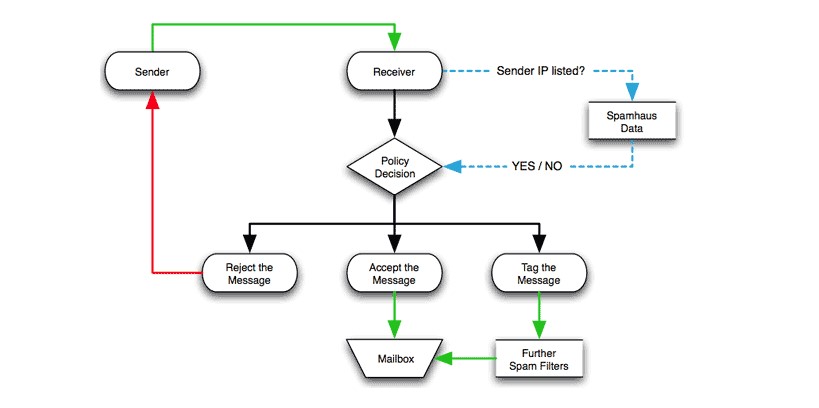What is an Email Blacklist? How to Avoid Your Emails Going to Blacklist?
We know how hard it is to build your email list.
You have to write unique copy, source images, format the message, choose your segments, and finally, send the email. All of these tasks can mean hours of work for you.
That’s why you should avoid email blacklists if you don’t want all your hard work to go down the drain.
Having an email blacklist can result in a dramatic drop in deliverability of your emails and eventually ruin your entire email marketing campaign. To avoid this, you need to understand how the email blacklist works first.
What is an email blacklist?
An email blacklist is, in fact, a real-time list of IP addresses or domains that are suspected of sending unwanted or spam emails.

The point of email blacklists is to avoid unwanted spam content, sent from untrustworthy sources, from cluttering inboxes. To make it easy to understand, you can think of blacklisting like blocking someone on social media channels: they can no longer send you private messages or comment on your profile.
Note: Keep in mind that spam can have different definitions for different people. Some spam is email that is meant to be harmful or malicious, trying to add a virus to your device or get you to do something you shouldn’t. However, a lot of people consider spam to be any email they don’t want or sign up for, but it is not harmful to them on their device.
Free mailbox providers, anti-spam vendors, email service providers (ESP), and internet service providers (ISP) use blacklists to prevent spam emails from entering their systems.
Actually, getting flagged by blacklist vendors will eventually add you to the list and block your content, then preventing your emails from reaching your audience’s boxes. If your business gets blacklisted, your email marketing campaign suffers, negatively affecting your email marketing ROI.
How do email blacklists work?
Spamhaus, the operator of one of the biggest blacklists, has set up a graphic to make it a bit easier to well understand how an email blacklist works. Your email will go through several tests to see if it should be sent to the recipient’s inbox or filtered as spam.

In short, when you send an email, it’s received by the ISP (Internet Service Provider), who has the upper hand to determine whether your email seems legitimate or not. If the ISP is using a blacklist, your email IP address is checked against the list. Then, it goes through the spam filters of the ISP to check for anything that they don’t allow. If your email passes these tests, it will be sent to the inbox.
The actual rejection of an email comes down to the ISP’s policies, as an email blacklist is just one of the main tools used to determine if an email is legitimate or not. As you can see clearly in the graphic above, an email can be delivered, rejected, or flagged as questionable mainly based on the information from the email blacklist and the policies of the ISP.
Please take note that a good history doesn’t shield you from the spam list. Any message containing spam traps will actually push you to any number to email blacklists in seconds.
There are 3 general types of email blacklist that you should know:
- Public blacklists. They are publicly available, meaning you can check at no cost.
- Private/ ISP blacklists. Generally, major ISPs have internal blacklists. Some allow you to check whether you are on their blacklist, while others don’t.
- Enterprise spam firewalls. This type is basically a subset of public blacklists, which is normally used by corporate IT departments.
5 reasons why your emails get blacklisted
Let’s face this fact: Anyone can have their email added to a blacklist. The online world is flooded with spam; thus mail servers had to find a way to combat those.
Now, you might wonder: “Why do my emails get blacklisted?” Below are X reasons you can look into.
-
Spam complaints. Every business will receive some complaints about their email marketing. Actually, that is not necessarily a bad thing. Nevertheless, if the number of complaints reaches beyond an acceptable threshold, the ISP might put you on the blacklist.
-
Bad email content. Some ISPs filter emails by keywords found in the body of the text. Words like “money-back guarantee,” “free,” text written in all caps, colored fonts, and a lot of exclamation marks can all be red flag content that could push you to a spam list.
-
Hackers. When your server is hijacked, there is a possibility that it’ll be used to launch phishing attacks on your subscribers. Once hackers attack your account, they use it to send large volumes of emails to your subscribers, which leads to the next point.
-
Sudden increase in your mailing list size. If the ISP notices a sudden spike in email traffic coming from your IP address, it can be a signal of spam content. Legitimate organizations are often supposed to build their email list slowly over an extended time, so sudden spikes look very suspicious.
-
Poor email list management. Poorly managed email lists can lead to unnoticed unsubscribe requests, which can get you flagged and blacklisted. If you don’t regularly check your email list, you might keep sending subscribers emails even if they unsubscribe, which leads to them tagging you as spam.
If you are sending mail through an Email Service Provider (ESP), chances are they will contact you if there is an issue with any of your emails or addresses. It is their business to make sure they can send large email quantities, so they usually clear up any blocks on their own IP addresses. However, if your email is the culprit, they will have a lot of questions for you about what you are sending and where your list came from.
3 indicators that your emails have been blacklisted
You will know your emails have been blacklisted if you realize the following indicators:
-
An increasing number of emails being dropped. This occurs when your recipient has reported your email as spam or has unsubscribed from your content.
-
Deteriorating delivery rates. Are your emails deleted even before your recipients open them? For marketers, it is essential that the email actually makes it to their target audiences’ inbox. So, if your delivery rates decrease significantly, it might be a signal of getting blacklisted.
-
A high number of email bounce rates. This happens when your messages cannot be delivered to the email addresses on your list and end up being returned to you.
So, to check the email blacklist, you can use the following tools:
-
Spamhaus. The platform runs numerous lists that are used by companies and ISPs across the world, such as SBL Spamhaus Block List, XBL Exploits Block List, DBL Domain Block List, and PBL Policy Block List. SBL is the one that most people are likely to run into when doing normal email marketing and sending to ISPs. Spamhaus has the strictest spam filtering policies out there. Therefore, if you aren’t listed here, chances are you are not listed on others too.
-
Spamcop. By using Spamcop, you will get the number of spam traps and spam reports that your IP has received. If this number is high, it means your IP’s reputation has already dropped. The platform can also help get your domain and IP delisted from blacklists.
-
Invalument. Invalument uses a combination of three blacklists that they manage, including ivmSIP, ivmURI, and ivmSIP/24. Much like Spamhaus, each list tracks different information but between them, IP and domains are on their lists.
-
Barracuda. Barracuda’s list comes from the company that sells data, email security hardware, and online software and is primarily made up of email addresses that spam their system.
-
MXToolbox. This is one of the popular checkers in the email community as it focuses on email-specific websites. What’s impressive about this tool is that it checks with 100 blocklist databases, which means you will get a detailed report of your status.
What should you do if you’ve been blacklisted?
The very first thing to do: Don’t panic.
Remember that there are hundreds of blacklists worldwide, and the chances are good your IP address is on at least one of them. For the most part, this won’t affect your ability to reach your audience too much. Smaller email blacklists are less likely to be used by major ISPs, and your address will probably drop off fairly quickly.
Nevertheless, if you’re on a blacklist, it could be an indicator that something is going wrong in your email marketing. So, there are 2 general best practices for delisting that can be great starting points for any email program.
#1. Spam rehab
To get off most blocklists, you should work directly with the blocklist operators and prove to them that you are actually a trustworthy sender. You can do this by strictly following email best practices for a particular period of time, which is kind of like following a spam rehab program.
#2. Permission pass campaigns
Another way is running permission pass campaigns. When you get blacklisted, your ESP will pinpoint the campaign that triggered it, allowing you to identify the email list that has spam traps. Once you find this list, you could run a permission pass campaign, where you send a one-off re-engagement email to the list’s contacts who have not interacted with your emails in a long time.
These contacts are most likely spam traps that triggered your blacklisting, so ensure you weed out all the accounts that don’t interact with your permission pass campaign.
7 tips to avoid your emails going to blacklist
Landing on an email blacklist can be both preventable and treatable by following these tips.
1. Use double opt-in for your subscribers
Double opt-in requires a two-step verification where subscribers sign up for your mailing list and receive an email with a link to once again confirm their subscription.
This can create an additional security measure to prevent fake emails, ensuring that your subscribers are real people and not bots. This additional signup step also makes sure that your subscribers really want to receive your emails, whether you are sending promotional offers, creating a newsletter, or alerting them to new offerings.
This also reduces potential complaints against your brand for email spamming and lowers the chances of people unsubscribing from your email list. You can use double opt-ins to acquire more qualified leads, build healthy relationships with new subscribers, and then improve your email deliverability.
2. Include an unsubscribe link
Violating anti-spam laws can actually get your company’s domain blacklisted, ao make sure to include an unsubscribe link to your email messages. This will keep you in adherence with regulations and legislation while improving your subscribers’ experience, too.
Adding an unsubscribe link to your emails can ensure you send your content only to people interested in receiving them.

Below are some tips for including an unsubscribe link in your emails.
-
Implement newsletter best practices. Remember to display your unsubscribe link so your audience can find them regularly, reducing the chances of them marking your email as spam.
-
Learn anti-spam laws. Don’t forget to familiarize yourself with the anti-spam rules in your own market, country, and state to ensure you follow proper practices and prevent getting blacklisted.
3. Clean your email lists regularly
Building a hefty email list can make you feel proud and accomplished. However, if it is filled with dead weight or unengaged contacts, it is better to trim the fat than stick with your pride.
In your database, any contact that has not engaged with your messages or opened one of your emails in a year could be a recycled spam trap. So, to clean your email list and avoid spam traps, you should:
-
Update your email list regularly. Send re-engagement emails to those who haven’t engaged with you for more than 6 months. Then, remove all unresponsive contacts to filter out potential spam traps.
-
Avoid list contamination. Check the spelling of your subscribers’ emails to prevent invalid email addresses and potential spam traps from contaminating your list. Plus, use email validation in your sign-up forms to prevent typos, as well as use email checker tools to verify the email addresses’ legitimacy. Remember to maintain a healthy contact list to avoid spam traps and improve your campaigns’ deliverability.
Note: It’s up to you to determine how long a subscriber’s disengagement with your email campaign deems them an inactive contact. However, if they don’t open your re-engagement email, it is probably a sign to scrub them off your list.
4. Optimize your email content
What you send to your subscribers keeps them interested and engaged in your emails. If you are sending out blanket emails to everyone on your list, you may get numerous spam complaints.
So, make sure you are sending what your subscribers are expecting from you and keep your content interesting to them by personalizing your emails and content. Besides, be mindful of how often you send your emails. If you suddenly sent to large lists or increased the frequency, you could see some trouble.
5. Secure your own server

Set proper security measures and use reliable tools to check IP addresses to protect your email server from bots or even malware that can hijack your IP address and email domain.
Harmful programs can send you fake emails, then get you blacklisted even if you are following proper email marketing practices. Utilizing an IP lookup tool or installing a VPN service can assist you in identifying unauthorized use of your IP address, indicating a possible network server breach.
Prevent malware infections as well as potential blacklisting of your business by setting up and updating email server security protocols.
6. Avoid entering email addresses into your database manually or mass emailing these types of contacts
After industry events, some sales teams often collect business cards from prospects, manually plug each email address into their database, and then send them a mass marketing email.
This can actually be a one-way ticket to getting blacklisted.
These people might expect an email from your company’s salesperson, but they never opted in to receiving content from your email program, so they are likely to never open them, or even worse, flag them as spam.
There is also a chance your sales team could make a typo while manually entering these email addresses into your database and, in turn, send emails to addresses that do not exist. This will significantly increase your email bounce rate, which also lowers your deliverability and heightens your risk of getting blacklisted.
If you want to add these contacts into your database, connect with them through their personal inbox and direct them to an offer, form, or landing page where they can opt themselves into your email marketing list.
7. Validate email addresses of your new subscribers
People try to subscribe to your email program but sometimes make a typo when entering your form’s contact information. Other times, if your business model requires them to enter their email address into a device manually, they can also make typos.
Unfortunately, email providers might bounce any email sent to addresses that don’t exist.
So, you can avoid this situation by using email address verification tools to validate each email address you collect from your subscription forms.
The final verdict
Ending up on an email blacklist can significantly hurt your email deliverability rate, which costs you valuable time and money, and negatively impacts your business relationships.
The good news is, this is entirely preventable and avoidable. No matter if you’re trying to remove yourself from a blacklist or avoid them, following the good sending habits in email marketing activities is the foundational step to creating successful campaigns.
We hope this article has helped you a lot. Contact us if you have any doubts about the email blacklist! We’re always happy to hear from you!
New Posts






